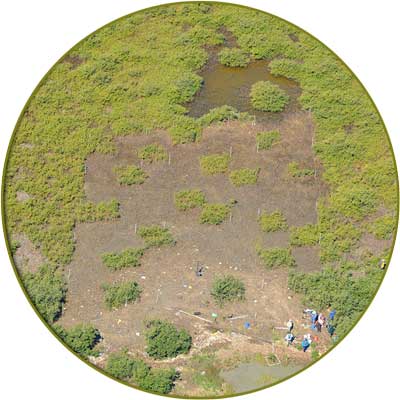Research
This page provides some technical background and our current project objectives. We welcome collaborations from other researchers — contact Steve Pennings (spennings@uh.edu) or Anna Armitage (armitage@tamu.edu) with any inquiries.
Project background
On the Texas coast, mangroves historically expanded into salt marshes during periods with warm winters, and contracted during periods with hard freezes (Sherrod and McMillan 1981, McMillan 1986). In the future, however, mangrove distributions are expected to steadily expand due to rising temperatures (Montagna et al. 2009). Models predict that an increase in winter minimum temperatures of 2-4° C may lead to black mangroves replacing salt marsh on 100% of the Texas coast and 95% of the Louisiana coast (Osland et al. 2013).
The objective of our study is to rigorously identify the consequences of mangrove expansion into salt marsh habitats, and to identify non-linearities and thresholds in ecosystem responses to mangrove density.
Because salt marsh and mangrove plants are both foundation species that create habitats and dominate ecological processes, this transition will likely have important consequences for wildlife, fisheries, and human economies (Ellison et al. 2005). Coastal wetlands in Texas support commercial and recreational fisheries (e.g., for red drum, Sciaenops ocellatus, and brown shrimp, Farfantepenaeus aztecus), improve water quality, reduce storm damage and erosion, and provide habitat for endangered species and for species such as birds that support a vigorous tourism industry (Moulton et al. 1997, Kennish 2001, Butzler and Davis 2006). Mangrove expansion will likely affect all these services, and require changes in the way that coastal resources are managed.
Scientists have begun to compare ecosystem services in mangroves and salt marshes (Bloomfield and Gillanders 2005, Moseman et al. 2009, Perry and Mendelssohn 2009), but how mangrove expansion will affect ecosystem services remains poorly understood. Recognizing the importance of this issue, Texas Sea Grant previously funded us to begin an experimental study of the consequences of mangrove expansion. The objective of our study is to rigorously identify the consequences of mangrove expansion into salt marsh habitats, and to identify non-linearities and thresholds in ecosystem responses to mangrove density. We have set up a large field experiment near Port Aransas, begun to sample adjacent marsh and mangrove sites for comparison, and begun an effort to engage citizen scientists in helping us monitor birds. We found immediate effects on microclimate (temperature, wind) and documented initial biotic responses in 2013 and 2014. We have received additional funding to continue the work through 2016. We hope to continue this experiment for at least 20 years in order to measure a wide variety of variables that will respond on different time scales.
Significance
Mangrove expansion into salt marshes is a global issue with important economic and cultural implications for human societies. To the best of our knowledge, our work represents the only large-scale experimental study of this issue anywhere in the world. This project will provide important information that will guide future management of coastal resources in Texas and throughout the Gulf Coast.

Methodology
We have established ten large (42 x 24 m) plots on Harbor Island, within the Mission-Aransas National Estuarine Research Reserve (see photo, left). We experimentally created a range of mangrove densities across these plots (plots range from 0 to 100% mangroves).
We are measuring a variety of abiotic and biotic variables to assess ecosystem responses to mangrove density. In addition, we have identified a set of field sites dominated by either marsh or mangrove vegetation that we are studying to expand our experimental results to a larger spatial scale.
Literature Cited
- Bloomfield, A. L. and B. M. Gillanders. 2005. Fish and invertebrate assemblages in seagrass, mangrove, saltmarsh, and nonvegetated habitats. Estuaries 28:63-77.
- Butzler, R. and S. Davis. 2006. Growth patterns of Carolina wolfberry (Lycium carolinianum L.) in the salt marshes of Aransas National Wildlife Refuge, Texas, USA. Wetlands 26:845-853.
- Ellison, A. M., M. S. Bank, B. D. Clinton, E. A. Colburn, K. Elliott, C. R. Ford, D. R. Foster, B. D. Kloeppel, J. D. Knoepp, G. M. Lovett, J. Mohan, D. A. Orwig, N. L. Rodenhouse, W. V. Sobczak, K. A. Stinson, J. K. Stone, C. M. Swan, J. Thompson, B. Von Holle, and J. R. Webster. 2005. Loss of foundation species: consequences for the structure and dynamics of forested ecosystems. Frontiers in Ecology and the Environment 3:479-486.
- Kennish, M. J. 2001. Coastal salt marsh systems in the US: a review of anthropogenic impacts. Journal of Coastal Research 17:731-748.
- McMillan, C. 1986. Isozyme patterns among populations of black mangrove, Avicennia germinans, from the Gulf of Mexico Caribbean and Pacific Panama. Contributions in Marine Science 29:17-25.
- Montagna, P. A., J. Brenner, J. Gibeaut, and S. Morehead. 2009. Coastal zone and estuaries.in J. Schmandt, J. Clarkson, and G. R. North, editors. The Impact of Global Warming on Texas. University of Texas Press, Austin, TX.
- Moseman, S. M., R. Zhang, P. Y. Qian, and L. A. Levin. 2009. Diversity and functional responses of nitrogen-fixing microbes to three wetland invasions. Biological Invasions 11:225-239.
- Moulton, D. W., T. E. Dahl, and D. M. Dall. 1997. Texas coastal wetlands: status and trends, mid 1950s to early 1990s. U.S. Fish and Wildlife Service, Albuquerque, New Mexico.
- NMFS. 2010. Fisheries Economics of the United States, 2009. Tech. Memo. NMFS-F/SPO-118, 172p., U.S. Dept. Commerce, NOAA, National Marine Fisheries Service.
- Osland, MJ, N. Enwright, RH Day, TW Doyle. 2013. Winter climate change and coastal wetland foundation species: salt marshes versus mangrove forests in the southeastern U.S. Global Change Biology. doi: 10.1111/gcb.12126.
- Perry, C. L. and I. A. Mendelssohn. 2009. Ecosystem effects of expanding populations of Avicennia germinans in a Louisiana salt marsh. Wetlands 29:396-406.
- Sherrod, C. L. and C. McMillan. 1981. Black mangrove, Avicennia germinans, in Texas: past and present distribution. Contributions in Marine Science 24:115-131.

